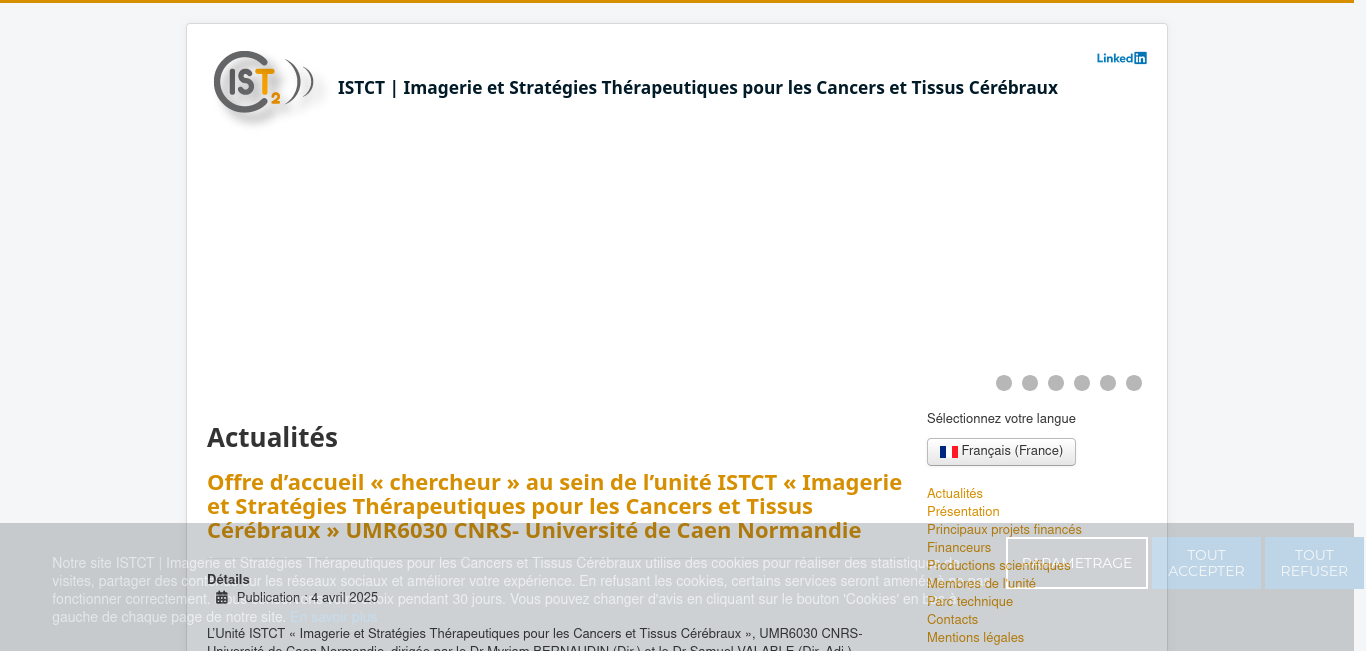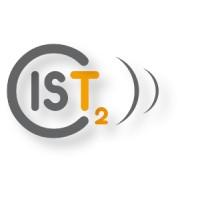Value proposition
[Automatic translation follows] The ISTCT unit "Imagery and therapeutic strategies for brain cancers and fabrics", UMR6030 is a mixed research unit of the CNRS and the University of Caen-Normandy (Unicaen) hosted at GIP Cyceron in Caen.
ISTCT's research activities aim to better understand the pathophysiology of hypoxic tumors (brain-poumon) and identify new therapeutic strategies targeting the tumor and its microenvironnement but also to protect the surrounding healthy fabric of anti-cancer treatments such as radiotherapy.
For example, in addition to molecular and/or cellular strategies targeting hypoxia, ISTCT studies the interest of Hadrons (carbon and protons ions) in combination with other therapies (chemotherapy, targeted therapies, radiosensituents ...) to treat radio tumors including glioblastomas. This project is part of the Archade scientific program and the recent opening in Caen de Cyclhad, a European Hadrontherapy Research Center. The effects of these therapies on healthy brain fabric are also evaluated in particular by in vivo (MRI, TEP/CT) and behavioral imaging methods. Molecular and/or non -drug neuroprotection/regeneration strategies such as physical activity are also studied.
ISTCT also seeks to offer new biomarkers to optimize treatments, to assess therapeutic efficiency early and to better orient therapy: among these biomarkers, ISTCT develops multimodal imaging approaches in MRI and PET as well as molecular approaches.
Neuroscience, cancers, brain, lung, biomedical imaging, radiotherapy, proton therapy, biomarkers, and hypoxico tumorsOriginal language
L’unité ISTCT « Imagerie et Stratégies Thérapeutiques pour les Cancers et Tissus Cérébraux », UMR6030 est une unité mixte de recherche du CNRS et de l’Université de Caen-Normandie (UNICAEN) hébergée au GIP CYCERON à Caen.
Les activités de recherche d’ISTCT visent à mieux comprendre la physiopathologie des tumeurs hypoxiques (cerveau-poumon) et identifier de nouvelles stratégies thérapeutiques ciblant la tumeur et son microenvironnement mais aussi à protéger le tissu sain environnant des traitements anti-cancéreux tels que la radiothérapie.
A titre d'exemple, outre des stratégies moléculaires et/ou cellulaires visant l'hypoxie, ISTCT étudie l'intérêt des hadrons (ions carbone et protons) en combinaison avec d'autres thérapies (chimiothérapie, thérapies ciblées, radiosensibilisants...) pour traiter les tumeurs radiorésistantes dont les glioblastomes. Ce projet s'inscrit dans le programme scientifique ARCHADE et l'ouverture récente à Caen de CYCLHAD, un Centre Européen de Recherche en Hadronthérapie. Les effets de ces thérapies sur le tissu cérébral sain sont également évalués notamment par des méthodes d'imagerie in vivo (IRM, TEP/CT) et comportementales. Des stratégies de neuroprotection/régénération moléculaires et/ou non médicamenteuses telles que l’activité physique sont également étudiées.
ISTCT cherche également à proposer de nouveaux biomarqueurs permettant d'optimiser les traitements, d'évaluer précocement l'efficacité thérapeutique et de mieux orienter la thérapeutique : parmi ces biomarqueurs, ISTCT développe des approches d'imagerie multimodale en IRM et TEP ainsi que des approches moléculaires.
Neurosciences, Cancers, Cerveau, Poumon, Imagerie biomédicale, Radiothérapie, Protonthérapie, Biomarqueurs, and Tumeurs hypoxiques
ISTCT | Imagerie et Stratégies Thérapeutiques pour les Cancers et Tissus Cérébraux - Actualités
Imagerie & Stratégies Thérapeutiques pour les Cancers & Tissus Cérébraux
https://www.istct.cyceron.fr/index.php/fr/

| Catalyst | Type | Tweets | Articles | |
|---|---|---|---|---|
 CNRS Research, Research Services | CNRS Research, Research Services | Other 9 Apr 2025 | | |
 Région Normandie National and local authorities, Government Administration | Région Normandie National and local authorities, Government Administration | Other 28 Feb 2025 | | |
 | Institut Carnot I2C | Other 9 Jun 2024 | | |
 | Institut Carnot ESP | Other 16 Apr 2024 | | |
